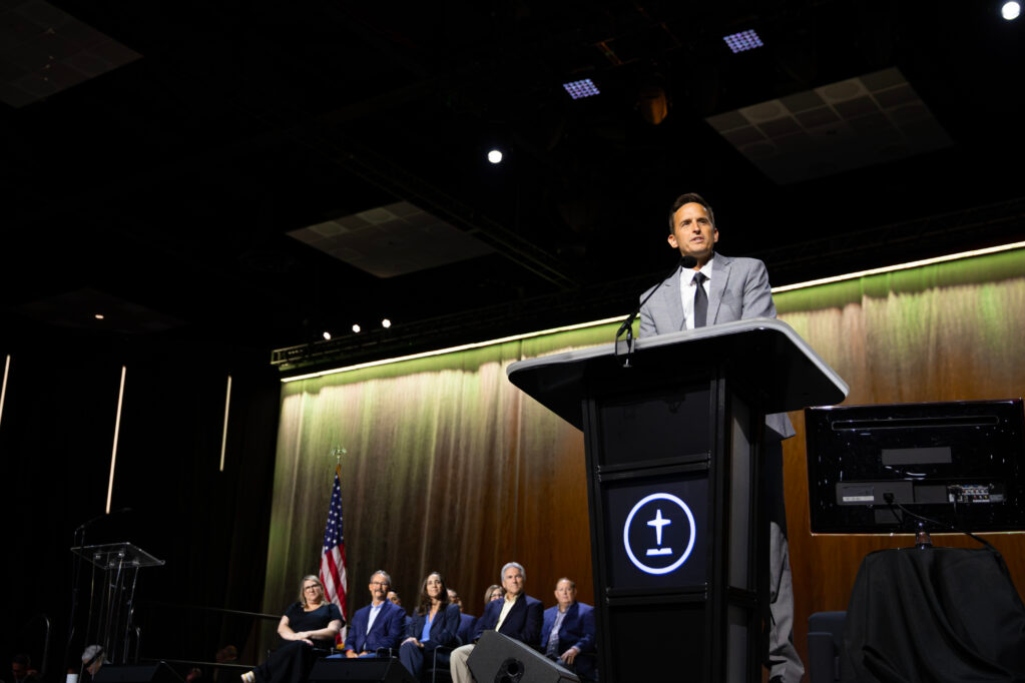
BRENTWOOD, Tenn. — G.K. Beale and Benjamin Gladd both discovered the depth of the connections between the Old and New testaments in a classroom, but they want to ensure many more hear about them in a Sunday sermon or even in their own personal Bible study.
The two leading New Testament scholars and friends have partnered together for multiple academic projects through the years. Now, they have pooled their decades of study for a practical resource designed for the everyday Bible student — the “CSB Connecting Scripture New Testament” from Holman Bibles.
Years ago, Gladd, executive director of The Carson Center for Theological Renewal at The Gospel Coalition, heard a lecture on how Jesus embodies Israel. “So, when the devil tempted Jesus in the wilderness for 40 days, Jesus was rehearsing Israel’s 40-year wandering in the wilderness,” said Gladd. “By aligning Jesus with the nation of Israel, a great deal of the Gospels’ presentations of Jesus made sense to me.”
Similarly, Beale, professor of New Testament at Reformed Theological Seminary, first heard someone explain the intricacies of how the Testaments relate in a seminary class. He has spent the last five decades helping others understand those connections. “As a Christian, the Old Testament is your book,” Beale said.
He added that “Connecting Scripture New Testament” is designed to help readers better understand that reality and the truth of Scripture. Then, with that foundation, move into deeper and better application of God’s Word.
“The New Testament isn’t simply an extension of the Old Testament,” Gladd said. “The New Testament is the culmination of God’s revelation. So, the New Testament writers go out of their way to present their message as the climax of the history of redemption.”
Gladd said the study of these connections, which has been a personal and academic passion of his, has helped his personal Christian walk and trust in the Bible. “Tracing thousands of connections between the two Testaments has increased my conviction of the inspiration of Scripture. How could it not?”
Innovative color-coding system
Both Gladd and Beale have been a part of numerous resources, from several books to commentary sets, that highlight how the New Testament writers drew on the Old Testament. They even worked together on several of those. But the “Connecting Scripture New Testament” grew from both a passion and a frustration.
They wanted all Bible readers to grasp the relationship between the two testaments but didn’t see the right resources available. “I’ve been frustrated at the nature of cross-references in our Bibles for years, but I couldn’t figure out how to improve them,” Gladd said.
Beale noted that there has been a significant demand among many of the more academic-minded readers and students for commentaries that highlight the relationship between the testaments, but this rarely gets distilled down to the typical Sunday school teacher or Bible reader.
They began to work with numerous methods before landing on a color-coding system. By embedding color within the text, they “opened up even more opportunities in demonstrating the connections between the Old and New testaments,” Gladd said.
There are few overlaps with other study Bibles, he added. “The presentation of the text, the color coding of the body and the cross-references, the running commentary at the bottom, and the robust indexes separate this study Bible from all the others. Reading the ‘Connecting Scripture New Testament’ is a completely different experience from any other Bible I’ve come across.”
It’s the new color-coding that “puts this information on the plate of the average reader,” Beale said. Old Testament quotations in the New Testament text are blue, allusions are shown as green, with all other text in traditional black. The Bible includes study notes that explain the connections, as well as relevant articles written by more than a dozen New Testament scholars.
“We are grateful for the opportunity to partner with Dr. Gladd and Dr. Beale on this unique resource,” said Andy McLean, a publisher with Holman. “The cross-reference system will help pastors, teachers and all students of God’s Word better grasp the depth of the connections between the testaments and Scripture’s overarching redemption story.”
More than co-authors
The “Connecting Scripture New Testament” was a decidedly joint project by the two scholars. Beale credited Gladd with the idea to use color-coding, while Gladd said Beale was adamant about using a three-color system.
They have been working together since Gladd was a student of Beale’s in the first Master’s in Biblical Exegesis program at Wheaton College. As Gladd first began working on what would become the “Connecting Scripture New Testament” study Bible, he knew he wanted Beale to help with the resource.
“Dr. Beale has arguably done more work on the New Testament’s use of the Old Testament than anyone alive,” Gladd said. “It simply made the most sense to bring him into the project. He made a number of critical suggestions that increased its usefulness.”
Recently, Beale used the “Connecting Scripture New Testament” as he worked on a project centered on Romans 8. He said the resource helped him as he considered the relationship between Paul’s writing and how the Old Testament discusses Israel’s time in the wilderness.
While Beale may have been the first to use the new resource, he hoped he wouldn’t be the last. When asked what he wanted readers to take away from the study Bible, he said he wanted others to “take from it. Study a passage. Look at the coloring and the notes to see where it is from. See how the Old Testament is used. Integrate it into a sermon or a lesson. Locate the New Testament passage within redemptive history.”
Gladd echoed Beale’s desire for the study Bible. “My hope and prayer are that God’s people will discover that they are not outsiders, peering into the story of redemption,” he said. “They are participants, living in the midst of the drama of redemption.”
For more information, visit ConnectingScripture.com.
(EDITOR’S NOTE — Aaron Earls is a writer for Lifeway Christian Resources.)


